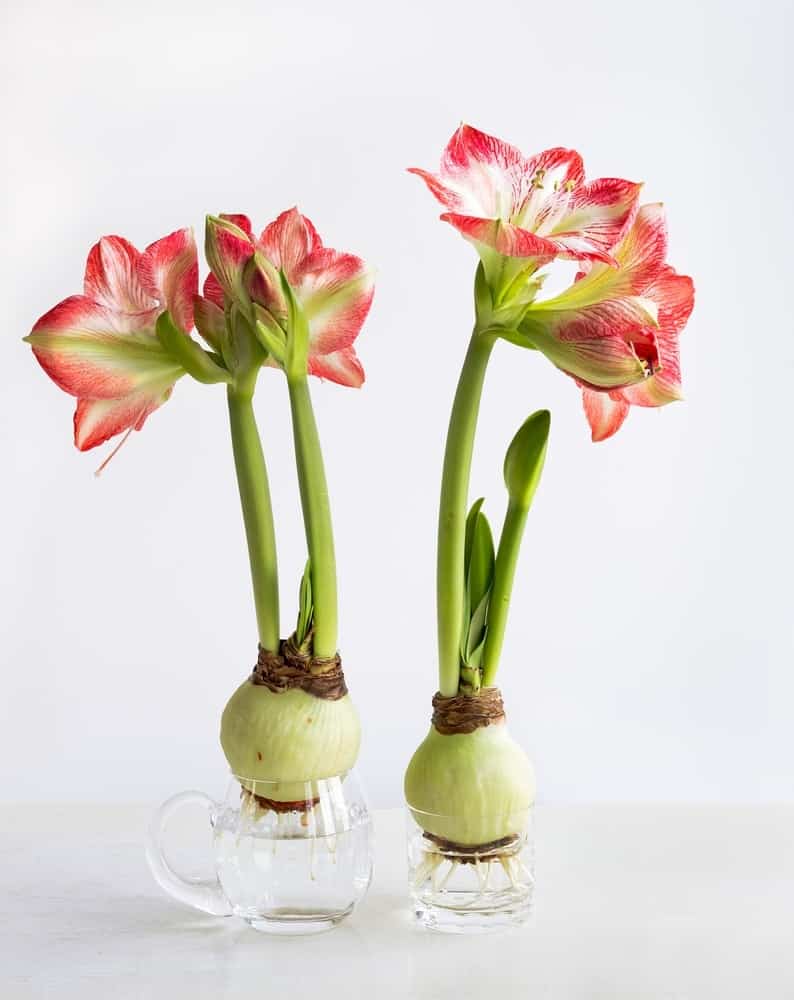The Amaryllis is generally grown as a winter-blooming houseplant. They belong to a group of tropical plants from South and Central America.
When they bloom, it is usually for seven weeks or more. To grow Amaryllis, you do so by planting bulbs. They generally bloom from March to May with some fall re-bloom possible.
What do Amaryllis Look Like
This plant has Lilly-like or bell-shaped flowers and comes in a wide array of colors, which include white, pink, salmon, bi-colored, red, pink, and orange. On each stalk, there will be two to six flowers. When you want to plant Amaryllis, you do it using bulbs, which are sold as South African or Dutch bulbs. You can use an old bulb you have saved or a new one that you just bought.
Can you Grow Amaryllis in Water?
The answer is yes you can with suitable care. It will bloom abundantly. The one drawback is that the bulbs cannot remain in this watery environment for the long term but it is a wonderful way to enjoy them over the winter. Most of the Amaryllis bulbs are grown in soil but they can be rooted easily and grown in water. One thing to keep in mind is to not let the bulb come in contact with the water because if it does, it will rot.
How to Grow Amaryllis in Water
To grow Amaryllis in water you will need, of course, the bulb, a jar or vase that is slightly larger than the bulb, stones, and water. They are the first thing that goes into the container. They can be about four inches thick or between two-thirds to three-fourths full. To help prevent odors, some like to add aquarium charcoal. They should be stones and not the tiny little pebbles. They should also be rinsed off before putting them in the container so they do not have anything on them that could interfere with the growth of the Amaryllis bulb.
On the bulb, trim off any dry, brown root using scissors as you want the roots to be white and fleshy to grow the flower. The next step is to place the root side of the bulb down on the pebbles or rocks, being sure to put some of the rocks around the bulb to help stabilize it. Make sure that you push the bulb slightly down into the rock but be sure that the top third of the bulb is exposed. Add some water until it is about an inch below the base of the bulb but no higher. It is very important that the only parts that touch the water are the roots and base of the bulb to prevent rotting of the bulb.

Water Care
Carrying for your Amaryllis starts immediately after planting.
Step One: Place your jar in a sunny windowsill
Step Two: The bulb depends on the warmth to help with sprouting so make sure that the temperatures are between 60-75 degrees
Step Three: Check the water level every day and add more water as needed but always make sure that the water level stays at an inch below the base of the bulb. When the water turns cloudy, you should change it.
Within a few weeks or months, you should notice a small shoot emerging from the top of the bulb. There should also be more root growth in the gravels. Sometimes you can the roots pushing between the rocks but other times you might not. Make sure that you are rotating the growing container to help promote even growth and to keep the stalks from leaning toward the light. The plant should bloom if you have done all these things, especially if you make sure it gets plenty of sunlight. After the flowers fade, you will need to either discard the bulb or transplant it into the soil so it can continue to grow.
Transplanting your Amaryllis Bulb
As you know, most of these bulbs do better in the soil so make sure that you plant it where it can get a lot of sunlight. If it starts to flower then you can increase the level of moisture. This plant can also thrive in filtered and partial sunlight. When the new growth appears you can use fertilizer if it is planted outdoors.
The Disadvantage of Growing Amaryllis in Water
When growing Amaryllis in water, it is an easy method but there is one big disadvantage to this method of growing. Once the bloom has finished, the bulb is likely not worth saving and replanting outside. It is advised that when using this method to use the least expensive bulbs you can find. When using the generic varieties, they may not display the outstanding size or unusual colors but they still have the ability to bloom as an expensive bulb.
Fun Facts About Amaryllis
- Amaryllis makes a great gift for anyone because they are reliable and carefree in regards to growing them.
- They will re-bloom year after year with the proper care
- The bigger the bulb the bigger flowers you will get
- They require water, warm temperatures, and strong light.
- Many use the water method of growing Amaryllis indoors in the winter
- Your bulb is exhausted after it flowers so you have to let it rebuild itself, which is why some let them start in water during the winter.
More like this: How Often to Water Fiddle Leaf Fig? [GUIDE]
Conclusion
Although you can grow Amaryllis in water it does not always do as well as those grown in soil. When you plant your bulb in the soil you also need to make sure that it is not water-logged. When you see it start to flower, you can then increase the moisture level in the soil. It does need direct sun no matter how you grow it. Make sure that after the last bloom fades you wash and rinse the stones and container before you use them again. These are beautiful flowers and make a great addition to your garden or your home during the winter.
Also read:
Victoria is the owner and main author of hobby plants. She loves spending her free time in her garden planting and taking care of her plants. Victoria hopes you enjoy the content here!

![The Best Stylish Grow Lights for Indoor Plants [REVIEWED] The Best Stylish Grow Lights for Indoor Plants [REVIEWED]](http://54.201.156.32/wp-content/uploads/2022/07/stylish-grow-lights-for-indoor-plants-300x158.jpg)
![How Often to Water Fiddle Leaf Fig? [COMPLETE GUIDE] How Often to Water Fiddle Leaf Fig? [COMPLETE GUIDE]](http://54.201.156.32/wp-content/uploads/2022/06/how-often-to-water-fiddle-leaf-fig-300x158.jpg)
![How To Bottom Water Plants [MOST EFFECTIVE TECHNIQUES] How To Bottom Water Plants [MOST EFFECTIVE TECHNIQUES]](http://54.201.156.32/wp-content/uploads/2022/07/how-to-bottom-water-plants-300x158.jpg)
![How Often Should You Water Pothos? [Complete Care Guide] How Often Should You Water Pothos? [Complete Care Guide]](http://54.201.156.32/wp-content/uploads/2022/07/how-often-to-water-pothos-300x158.jpg)
![How Often Do You Water A Snake Plant? [FIND OUT HERE] How Often Do You Water A Snake Plant? [FIND OUT HERE]](http://54.201.156.32/wp-content/uploads/2022/07/how-often-do-you-water-a-snake-plant-1-300x158.jpg)
![How Often Should You Water Ferns? [COMPLETE CARE GUIDE] How Often Should You Water Ferns? [COMPLETE CARE GUIDE]](http://54.201.156.32/wp-content/uploads/2022/08/how-often-to-water-ferns-300x158.jpg)